This past year, I began teaching MBA business communication at the University of Iowa’s Tippie College of Business. The focus of the curriculum is writing and presenting. This skillset is unique in that employers consistently cite it as important while graduates continue to wish that they had more instruction in this area.
While writing is a singular skill we can build through refined practice over time, public speaking is a complex suite of skills further compounded by nerves and social anxiety. Standing up in front of others and speaking — especially in a high-stakes business setting — is a horrifying prospect to many. Need proof? When asked their greatest fear, a majority of Americans rank public speaking as more terrifying than death itself. This led Jerry Seinfeld to quip, “This means to the average person, if you go to a funeral, you’re better off in the casket than doing the eulogy.” But when you get past these primal fears, there are strategies for leveling up.
As a professional speaker and college educator trained in theatre arts and improv comedy, I have a lot of experience being at the front of the room. However, I researched development of these skills even further in preparation for this course. A while back I shared six books to help you write more effectively. In keeping with this theme, I thought I’d share some of my favorite books on speaking, presenting, creating slides, and connecting with your audience.
Persuasive Presentations by Nancy Duarte
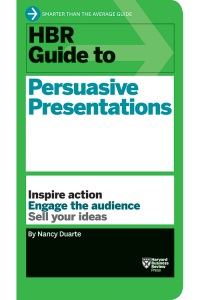 What Strunk and White are to writing, Nancy Duarte is to public speaking. While Duarte’s books Slideology and Resonate offer visual impact, I’ve assigned her manual Persuasive Presentations in my MBA Business Communication class because it offers a tactical, practical guide on both structuring and delivering your presentation. She also offers insights on slide design (she famously helped Al Gore transform his carousel of photos into the slide deck that became An Inconvenient Truth). This is the one book on presenting everyone needs. Among her many useful techniques is the idea of creating a STAR moment during your talk — leaving your audience with Something They’ll Always Remember.
What Strunk and White are to writing, Nancy Duarte is to public speaking. While Duarte’s books Slideology and Resonate offer visual impact, I’ve assigned her manual Persuasive Presentations in my MBA Business Communication class because it offers a tactical, practical guide on both structuring and delivering your presentation. She also offers insights on slide design (she famously helped Al Gore transform his carousel of photos into the slide deck that became An Inconvenient Truth). This is the one book on presenting everyone needs. Among her many useful techniques is the idea of creating a STAR moment during your talk — leaving your audience with Something They’ll Always Remember.
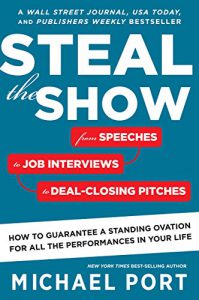 Steal the Show by Michael Port
Steal the Show by Michael Port
Building on Duarte’s primer, professional actor turned speaking professional Michael Port applies his years of training in stage craft to speeches, job interviews, and pitches. With chapters on improvisation, stage fright, and audience interaction, Steal the Show helps you do just that. In addition to a “cheat sheet” of 50 public speaking tips, Port also includes a section on the lessons of improvisation comedy including the importance of saying “Yes, and …”
Presentation Zen by Garr Reynolds
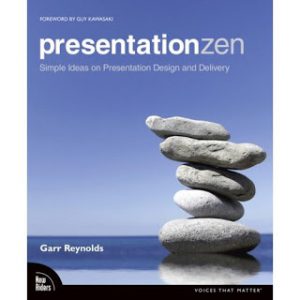 If Steal the Show provides greater depth on delivery and stagecraft, Presentation Zen offers the same on the topic of slide design. While Reynolds’ book spends ample time teaching, the pages are filled with examples illustrating key points. Showing is always better than telling but it’s even more important when it comes to something visual like slide design. This is especially clear when the book shows the same slide content two different ways to illustrate the contrast between clear, simple slides vs. their crowded, complex counterparts.
If Steal the Show provides greater depth on delivery and stagecraft, Presentation Zen offers the same on the topic of slide design. While Reynolds’ book spends ample time teaching, the pages are filled with examples illustrating key points. Showing is always better than telling but it’s even more important when it comes to something visual like slide design. This is especially clear when the book shows the same slide content two different ways to illustrate the contrast between clear, simple slides vs. their crowded, complex counterparts.
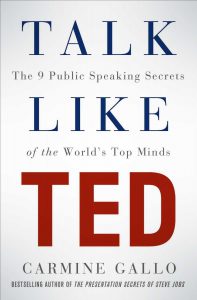 Talk Like TED by Carmine Gallo
Talk Like TED by Carmine Gallo
TED talks offer consistently powerful examples of public speaking. Journalist Carmine Gallo analyzes the best practices used in creating these 18-minute talks and distills the lessons into frameworks that any presenter can use. Talk Like TED breaks down the science of storytelling covering everything from Aristotle to Dale Carnegie to Steve Jobs. Gallo concludes each chapter with actionable “TEDnotes” with application exercises like a helpful Message Map template.
No One Understands You and What To Do About It by Heidi Grant
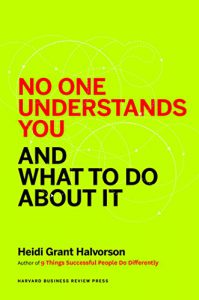 Beyond structuring your talk and designing your slides, the art of communication is about mastering how you present yourself to others and — just as important — how your audience perceives you. Heidi Grant is a social psychologist at the Motivation Science Center at Columbia Business School. Her book No One Understands You and What To Do About It uses science to answer these two very big questions. Don’t let the research foundation scare you. Grant employs a conversational tone and pop culture references from the likes of The Simpsons to keep this insightful book moving.
Beyond structuring your talk and designing your slides, the art of communication is about mastering how you present yourself to others and — just as important — how your audience perceives you. Heidi Grant is a social psychologist at the Motivation Science Center at Columbia Business School. Her book No One Understands You and What To Do About It uses science to answer these two very big questions. Don’t let the research foundation scare you. Grant employs a conversational tone and pop culture references from the likes of The Simpsons to keep this insightful book moving.
If I Understood You Would I Have This Look on My Face by Alan Alda
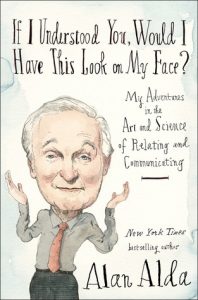 Yes — that Alan Alda. While many are most familiar with his acting work, Alda has spent years as the host of Scientific American Frontiers on PBS. In that time, the actor discovered that while scientists can create life-saving advancements, they can’t always explain their innovations. Like Port, Alda stresses the importance of improv. He also reframes our understanding of what communication between two people is. It’s not just communicating, it’s relating with one another. (I had the opportunity to interview Alda about his work last fall. You can listen to the podcast here.)
Yes — that Alan Alda. While many are most familiar with his acting work, Alda has spent years as the host of Scientific American Frontiers on PBS. In that time, the actor discovered that while scientists can create life-saving advancements, they can’t always explain their innovations. Like Port, Alda stresses the importance of improv. He also reframes our understanding of what communication between two people is. It’s not just communicating, it’s relating with one another. (I had the opportunity to interview Alda about his work last fall. You can listen to the podcast here.)
These last two recommendations serve as good reminders of how big the task of public speaking is. It’s not just you at the front of the room presenting. It’s you connecting to and relating with your audience. No wonder so many find the task daunting!
Public speaking is not a singular skill with one focused area for improvement. It’s a multi-disciplinary pursuit requiring mastery of storytelling, structure, design, delivery, and audience engagement. Honestly, there’s not one book that does all of this. But reading a variety of books like those listed here can help you improve your presence with each talk you give.

